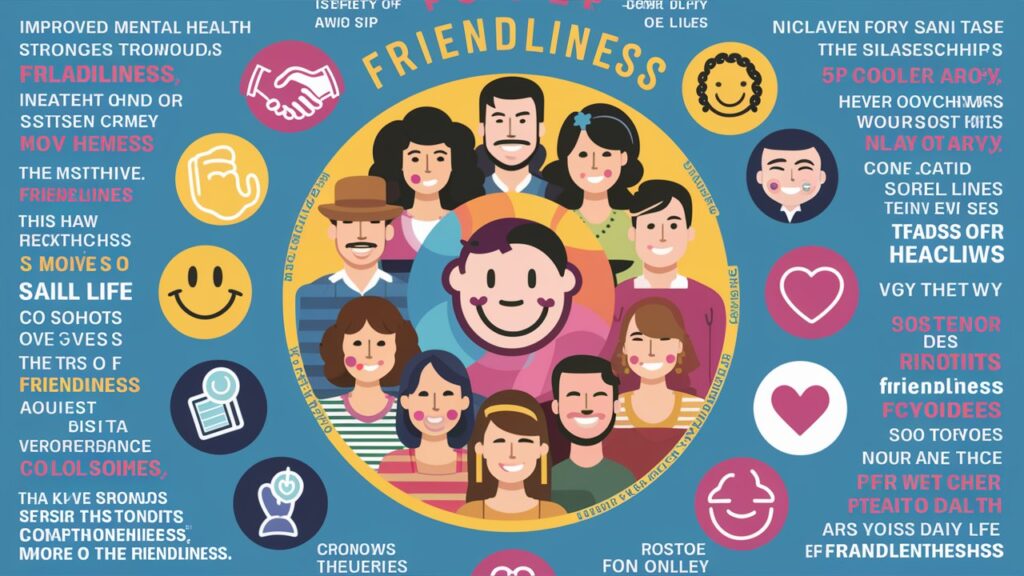Introduction: What Does “Friendlier” Really Mean?
Friendliness is more than just a smile or a polite greeting—it’s a mindset rooted in empathy, openness, and a genuine desire to connect with others. The term “friendlier” refers to behaviors, environments, or attitudes that foster warmth, approachability, and mutual respect. In a world where stress and isolation are increasingly common, embracing a friendlier demeanor can transform relationships, workplaces, and communities. This article explores the multifaceted meaning of friendliness, its psychological and social benefits, practical ways to cultivate it, and answers to common questions about its role in modern life.
Defining Friendliness: Beyond Surface-Level Kindness
Friendliness goes beyond superficial niceties. It involves actively listening, showing empathy, and creating spaces where others feel valued. A “friendlier” approach could mean adjusting your communication style to be more inclusive, offering help without being asked, or simply acknowledging someone’s presence with authenticity. For example, a friendlier workplace might prioritize collaboration over competition, while a friendlier neighborhood could involve small acts of solidarity, like checking in on elderly residents. The core of friendliness lies in intentionality—choosing to prioritize compassion even when it requires effort.
The Psychological Benefits of Being Friendlier
Adopting a friendlier attitude has profound effects on mental health. Studies show that acts of kindness release oxytocin, a hormone linked to reduced stress and increased feelings of happiness. When we engage in friendly interactions, we not only uplift others but also reinforce our own sense of purpose. For instance, volunteering, mentoring, or even striking up conversations with strangers can combat loneliness and foster resilience. Friendliness also builds emotional intelligence, helping us navigate conflicts with patience and understanding. Over time, these habits create a positive feedback loop, making kindness feel less like an obligation and more like a natural response to the world.
Friendliness in Social Dynamics: Building Stronger Communities
Communities thrive when friendliness becomes a cultural norm. In neighborhoods, schools, or online spaces, a friendlier atmosphere encourages trust and cooperation. Consider initiatives like community gardens, local mentorship programs, or inclusive events designed to bridge cultural divides—these are all products of collective friendliness. On a smaller scale, simple gestures like holding the door for someone or offering a sincere compliment can ripple outward, inspiring others to pay it forward. Importantly, friendliness doesn’t demand grand gestures; consistency in small acts often has the most lasting impact.
Friendliness in the Workplace: Boosting Morale and Productivity
A friendlier work environment is a cornerstone of employee satisfaction and efficiency. Leaders who model approachability and empathy create teams where creativity and innovation flourish. For example, companies that prioritize “psychological safety”—where employees feel safe to voice ideas without fear of ridicule—often see higher engagement and lower turnover. Similarly, peer-to-peer friendliness, such as recognizing a colleague’s contributions or offering support during tight deadlines, strengthens team cohesion. Organizations that invest in friendliness through policies like flexible work hours or mental health resources not only retain talent but also build reputations as desirable places to work.

How to Cultivate a Friendlier Mindset
Becoming friendlier starts with self-awareness. Begin by reflecting on your default reactions: Do you approach interactions with curiosity or judgment? Practice active listening by focusing entirely on the speaker rather than formulating your response. Small daily habits, like expressing gratitude or smiling at strangers, can rewire your brain to default to kindness. Additionally, challenge yourself to step outside your comfort zone—attend social events, join clubs, or volunteer. Over time, these actions build confidence and make friendliness feel effortless. Remember, friendliness isn’t about perfection; it’s about progress.
Overcoming Barriers to Friendliness
Despite its benefits, cultivating friendliness isn’t always easy. Busy schedules, social anxiety, or past negative experiences can create barriers. To overcome these, start small. Set achievable goals, like complimenting one person daily or initiating a conversation with a coworker. If shyness is an obstacle, focus on non-verbal cues—eye contact, nodding, or open body language—to signal approachability. For those recovering from hurtful interactions, therapy or mindfulness practices can help rebuild trust in others. Friendliness is a skill that grows with practice, and setbacks are part of the journey.
Conclusion: Why Friendliness Matters Now More Than Ever
In an era marked by polarization and digital detachment, friendliness serves as a bridge between divides. It reminds us of our shared humanity and empowers us to create environments where everyone feels seen and respected. Whether through a kind word, a supportive gesture, or a culture shift in our communities, choosing friendliness is a radical act of hope. By embracing its true meaning, we not only improve our own lives but also contribute to a more compassionate world.
Frequently Asked Questions (FAQs)
1. How can I be friendlier without seeming insincere?
Authenticity is key. Focus on small, genuine actions rather than forced gestures. For example, ask thoughtful questions or offer help where you’re truly able. People recognize and appreciate sincerity over performative kindness.
2. What if my friendliness is met with negativity?
Not everyone will reciprocate, and that’s okay. Friendliness is about your actions, not others’ responses. Stay consistent—your behavior may inspire change over time, or at least maintain your own peace of mind.
3. Can workplaces measure the impact of friendliness?
Yes! Metrics like employee retention rates, survey feedback on workplace culture, and productivity levels often reflect the effects of a friendlier environment. Happy teams typically outperform stressed ones.
4. How do I teach children to be friendlier?
Model kindness in your interactions and praise empathetic behavior. Encourage activities that require cooperation, like team sports or group projects, and discuss the emotions of characters in books or movies.
5. Is friendliness culturally universal?
While expressions of friendliness vary across cultures, the core values of respect and empathy are global. Research local customs when interacting with different communities to ensure your gestures are appropriate.
By embracing the true meaning of “friendlier,” we unlock the potential to transform everyday interactions into opportunities for connection and growth. Let kindness be your compass. 🌟
